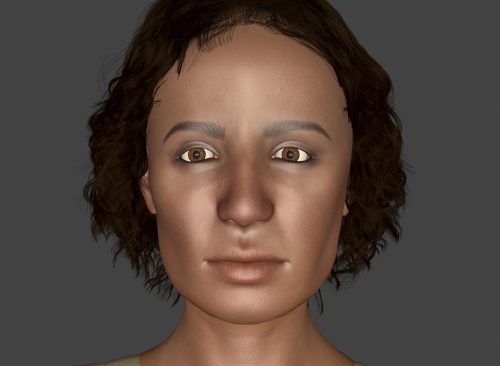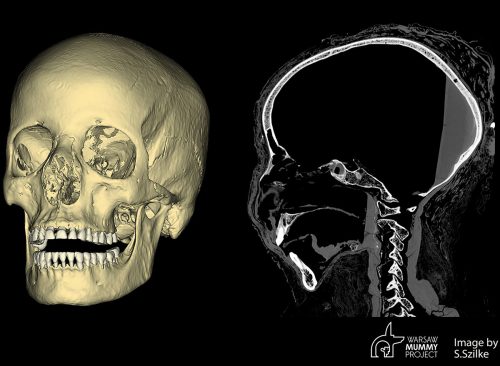Scientists Reconstructed the Face of a 2,000-Year-Old Pregnant Egyptian Mummy
Woman cause of death also revealed.

European scientists have reconstructed the face of an Egyptian woman who died 2,000 years ago, using her mummified remains. During their analysis, the researchers discovered that the woman, dubbed “The Mysterious Lady,” was pregnant. The scientists, based at the University of Warsaw, believe the woman was between the ages of 20 and 30, was a member of an elite family, and was about 28 weeks pregnant when she died two millennia ago.
Analyzing her skull and other remains, they created images of what she might have looked like while alive, the Daily Mail reports. Read on to find out how the scientists did it and their other surprising discovery about her life and death.

In the 1800s, the Mysterious Lady was discovered in royal tombs in northern Egypt. Scientists dated the body to the first century BC. Originally, it was thought to be the remains of a priest, but in 2016, the mummified body was found to be an embalmed woman.
Her body had been carefully wrapped in fabrics and buried with amulets, which were believed to provide protection in the afterlife. “Mummification was an expression of the care given to preserve a person for the afterlife,” the Warsaw Mummy Project said on Facebook.

Researchers from the University of Warsaw, aided by two forensic specialists, used 2D and 3D techniques to reconstruct her face. “Facial reconstruction is mainly used in forensics to help determine the identity of a body when more common means of identification such as fingerprint identification or DNA analysis have drawn a blank,” said forensic artist Hew Morrison.
“Reconstructing an individual’s face from their skull is often considered as a last resort in an attempt to establish who they were. It can also be used in an archaeological and historical context to show how ancient people or famous figures from the past would have appeared in life.” “In a historical context, the process helps to figuratively bring the deceased back to life, thus fostering respect and sensitivity for the deceased who are either the subject of research or are being exhibited in museums,” he added.

“Our bones and the skull in particular, give a lot of information about the face of an individual,” said Chantal Milani, an Italian forensic anthropologist and member of the Warsaw Mummy Project. “Although it cannot be considered an exact portrait, the skull like many anatomical parts is unique and shows a set of shapes and proportions that will appear in the final face.”
“The face that covers the bone structure follows different anatomic rules, thus standard procedures can be applied to reconstruct it, for example to establish the shape of the nose,” she added. “The most important element is the reconstruction of the thickness of the soft tissues at numerous points on the surface of the facial bones. For this, we have statistical data for various populations across the globe.”

“For many people, ancient Egyptian mummies are curiosities and some people tend to forget that these were once living people who had their own individual lives, loves, and tragedies,” said Dr. Wojciech Ejsmond, an archeologist from the Polish Academy of Sciences. “We can say that forensic experts provide faces for the scientific data, so the person is then no longer an anonymous curiosity in a showcase.” The facial reconstructions debuted in an exhibit at the Silesia Museum on Nov. 3.
RELATED: The 10 Most “OMG” Science Discoveries of 2022

CT scans of the body enabled scientists to make two major discoveries: The woman’s potential cause of death, and the likelihood that she was pregnant when she died. The fetus was detected in the lower part of the pelvis and had been mummified along with its mother. Researchers measured head circumference, determining it was between 26 and 30 weeks of gestation.
The scans also uncovered information that suggests the cause of the woman’s death. Researchers say she probably died from nasopharyngeal cancer, which affects the part of the throat that connects nasal passages to the back of the mouth. Unusual marks on the skull suggested it had been affected by this type of cancer.














